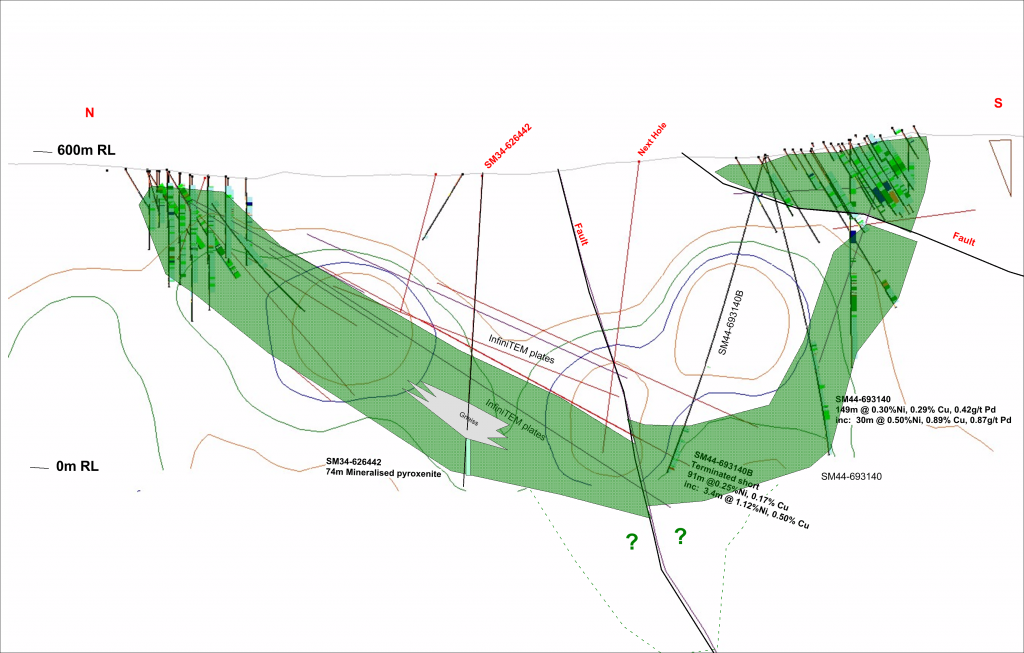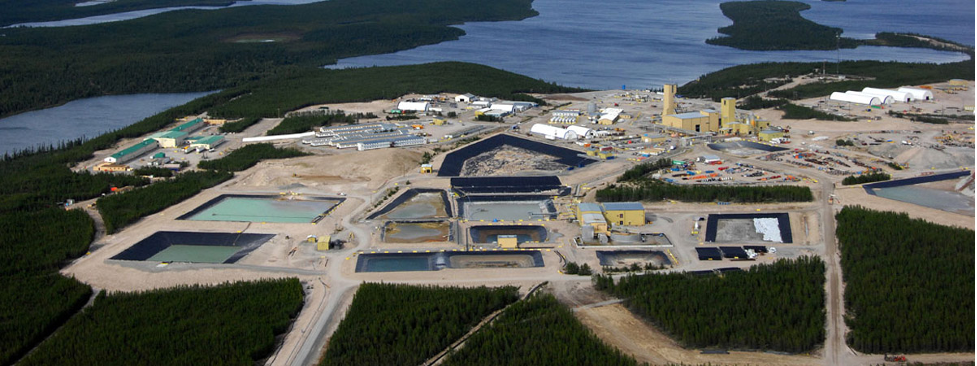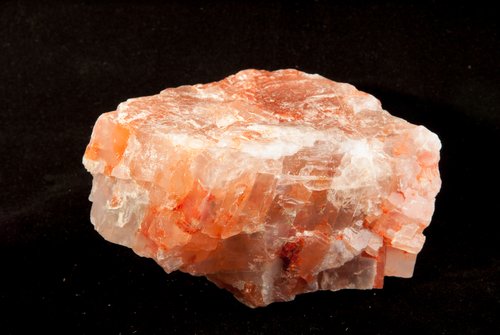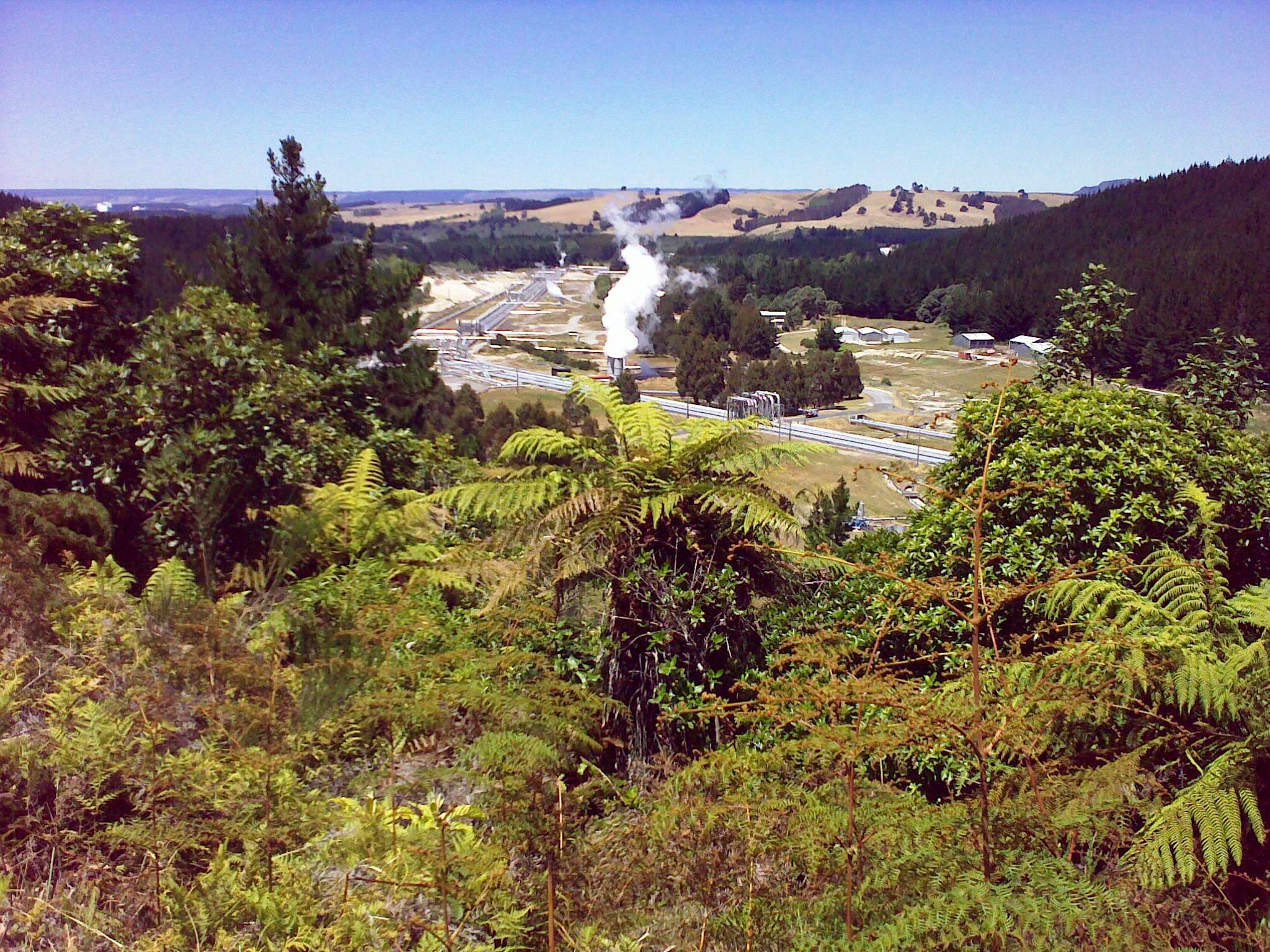While no one would call these grades high, they appears to be an improvement over their current resource grade of 0.24%. They are also a fair bit deeper.
[box type=”info” align=”aligncenter” ]Disclaimer: This is an editorial review of a public mining company press release and is not an endorsement. It may include opinions or points of view that may not be shared by the companies mentioned in the release. The editorial comments are highlighted so as to be easily separated from the release text and portions of the release not affecting this review may be deleted. Read more at How to Use this Site.[/box]
MONTREAL, QUÉBEC–(Marketwired – Aug. 12, 2014) – (TSX VENTURE:SME). Sama Resources Inc./Ressources Sama Inc. (“Sama” or the “Company“) is pleased to announce that the Company has confirmed the pipe-like intrusion as a 1.6 kilometre (“km“) long, large fold linking the Samapleu Main and the Extension 1 deposits and solidifies the geological model at depth. In addition, exploration hole SM44-693140 intercepted a continuous mineralized zone of 149 metres (“m“) grading 0.30% nickel 0.29% copper, 0.04% cobalt, 0.42 gram per tonne (“gpt“) palladium at the Samapleu Main nickel-copper-palladium deposit in Côte d’Ivoire, West Africa.
[box type=”note” align=”aligncenter” ]Sama Resources is a junior exploration company exploring its Samapleu Nickel-Copper-Palladium deposit located in the Ivory Coast of west Africa. Based on these latest drill results the company has described the host rock as a pipe-like intrusion that has been folded. Folding is a process where tectonic forces can squeeze rocks into concave or convex shapes. As illustrated in the diagram below the company has outlined in green a large “syncline” or convex shape. This interpretation may help the company plan further drill holes and intercept mineralization. [/box]

The SM44-693140 interval started 347m from surface and included several semi-massive high grade sulphide lenses, including a 30m combined interval grading 0.50% nickel, 0.89% copper and 0.83 gpt palladium within intercepts of up to 2.06% nickel and 1.54% nickel.
“These impressive intercepts confirm the magnitude of the newly discovered system that form part of what we believe to be the next world class polymetallic district in West Africa”, commented Dr. Marc-Antoine Audet, President and CEO of Sama. “This large pipe-like intrusion has strong similarities with other world class deposits such as Jinchuan (515 million tonnes (“Mt”) at 1.06% nickel), Voisey Bay (137Mt at 1.68% nickel), Kabanga (52Mt at 2.65% nickel), Eagle (4.5Mt at 3.33% nickel), Eagle Nest (20Mt at 1.68% nickel) and Kalatongke (24Mt at 0.68% nickel).” Dr. Marc-Antoine Audet added.
Two additional boreholes were drilled in June-July 2014; SM44-683140B and SM34-626442. Both targeted strong Tri-dimensional Conductivity Depth Imaging (“CDI“) targets. Hole SM44-683140B intercepted a total of 91m of mineralized pyroxenite with several semi-massive to massive sulphide stringers and lenses before been terminated within the mineralization due to maximum depth capability of our drill rig. Tenors of up to 6.55% copper and an interval of 3.4m grading 1.12% nickel, 0.50% copper and 1.61gpt palladium were intercepted at the bottom of the hole which suggest that the mineralization continued at depth. The hole will be deepened using a more powerful drilling rig in order to fully test the bottom of the pipe-like intrusion that forms the large fold and returns very strong conductivity responses over a strike length of 1.6km and links the Samapleu Main and the Extension 1 deposits.
[box type=”note” align=”aligncenter” ]Pyroxenite is an ultramafic rock that forms deep within the earths crust or upper mantle and contain high temperature minerals known as pyroxenes. The metal sulfides in this deposit occur as “stringers” or large veins and lenses within this type of rock.
During diamond drill planning, companies usually define a target depth or max depth that a drill should reach when testing exploration targets. However if the drill encounters significant mineralization to continue beyond the target depth. The general rule of thumb is to keep drilling as it could lead to a discovery hole and pay out in the markets. Between the months of June and July Sama drilled two holes targeting an electromagnetic anomaly. It’s unfortunate for Sama Resources that drilling had ceased in what appeared to be comparable grades to the deposits mentioned above. They don’t say what type of drill rig was used, nor do they say what core size was assayed, but they do allude to having an underpowered drill. The company plans on deepening the hole to test the extent of this high grade mineralization.[/box]
Hole SM34-626442 is currently being assayed.
The current drilling program is targeting strong CDI targets generated from the Helicopter Electromagnetic survey (HTEM) in the vicinity of the Samapleu Main, Extension 1 and the Yepleu deposits. All high priority CDI’s targets could be related to the presence of mineralization in various concentrations including semi-massive to massive lenses within what Sama believes to be the mineralized trend extending at depth and also laterally.
[box type=”note” align=”aligncenter” ]Sama used an airborne electromagnetic survey to plan out this diamond drill program. EM surveys can help identify conductive rock masses like metallic sulfide minerals.[/box]
The table set out below shows the details for mineralized intercepts. Intercepts were defined using 0.1% nickel cut-off grades.
| HOLE-ID | FROM | TO | LENGTH | Nickel | Copper | Cobalt | Platinum | Palladium |
| m | m | m | % | % | % | g/t | g/t | |
| Samapleu Main & Extension 1 | ||||||||
| SM44-693140 | 347.00 | 495.85 | 148.85 | 0.30 | 0.29 | 0.02 | 0.10 | 0.42 |
| Including | 347.00 | 356.20 | 9.20 | 0.46 | 1.12 | 0.02 | 0.11 | 1.11 |
| Including | 359.00 | 363.70 | 4.70 | 0.22 | 1.01 | 0.01 | 0.08 | 0.53 |
| Including | 368.85 | 369.90 | 1.05 | 1.54 | 0.82 | 0.06 | 0.23 | 1.72 |
| Including | 372.15 | 373.50 | 1.35 | 0.82 | 1.03 | 0.04 | 0.30 | 0.94 |
| Including | 408.60 | 409.10 | 0.50 | 2.06 | 1.30 | 0.08 | 0.17 | 3.54 |
| Including | 431.00 | 433.00 | 2.00 | 0.61 | 0.65 | 0.02 | 0.06 | 1.00 |
| Including | 435.00 | 436.00 | 1.00 | 0.70 | 0.53 | 0.03 | 0.11 | 0.9 |
| Including | 469.00 | 473.00 | 4.00 | 0.46 | 0.53 | 0.02 | 0.19 | 0.46 |
| Including | 480.00 | 485.00 | 5.00 | 0.36 | 0.54 | 0.02 | 0.14 | 0.42 |
| Including | 494.00 | 494.80 | 0.80 | 0.27 | 0.57 | 0.01 | 0.09 | 0.37 |
| SM44-693140b | 513.20 | 604.40 | 91.20 | 0.25 | 0.17 | 0.02 | 0.04 | 0.24 |
| Including | 513.95 | 514.25 | 0.30 | 0.19 | 6.55 | 0.01 | 0.16 | 1.99 |
| Including | 594.15 | 597.55 | 3.40 | 1.12 | 0.50 | 0.06 | 0.22 | 1.61 |
[box type=”note” align=”aligncenter” ]
The intervals only represent the apparent thickness of the unit intercepted, but the company’s interpretation of the mineralized rock unit gives us some idea of what they think might be down there. As they continue to drill the interpretation will evolve.
There are about 30 meters of mineralized rock in the 148.85m interval they have reported in hole #693140. The entire interval – including the barren portions – assay at an average grade of 0.3% nickel. While no one would call these grades high, they appears to be an improvement over their current resource grade of 0.24%. They are also a fair bit deeper.
[/box]
The technical information in this release has been reviewed and approved by Dr. Marc-Antoine Audet, P.Geo and President and CEO of Sama, and a ‘qualified person’, as defined by National Instrument 43-101, Standards ofDisclosure for Mineral Projects.
[box type=”note” align=”aligncenter” ]Sama Resources stock is currently trading at $0.35 near its 52-week high of $0.37. The stock made some significant gains in June when the company announced high grades from its Lona graphite deposit in the Republic of Guinea. The have also likely benefited from improve nickel and palladium prices.
[/box]
[box type=”success” align=”aligncenter” ]Have a company or release you’d like us to look at? Let us know through our contact page, through Google+, Twitter or Facebook.[/box]






